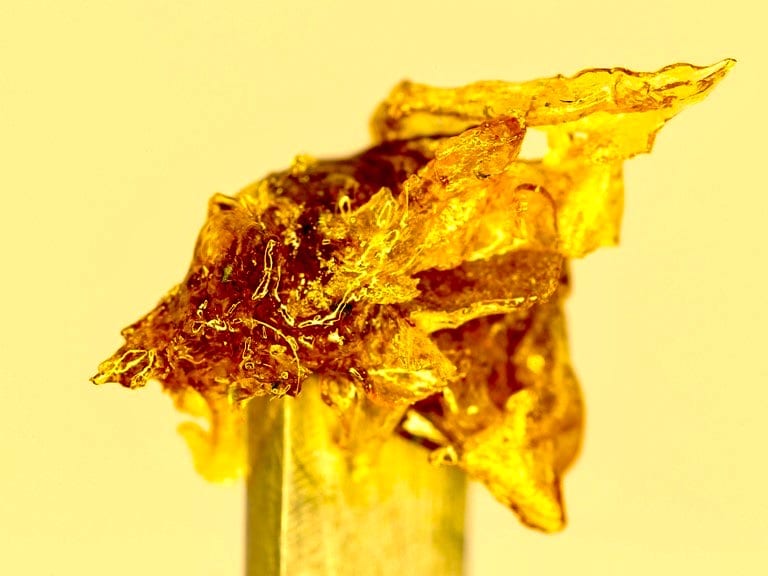While most countries are still hesitating to legalize weed in its simplest form, in the United States, the cannabis industry is outbidding its competitors with increasingly potent products that are dangerous to consumers’ health. Among them is BHO, a concentrate with a THC content of up to 80%. Zeweed reports on this extreme (and hardly recommended) extract.
BHO (Butane Hash Oil) is a cannabis flower extraction that first appeared in the 70s with The Brotherhood Of Eternal Love, the Orange County hippie mafia in the USA. This brotherhood of drug lovers produced its oil in Afghanistan and sold it in California. This highly lucrative operation was short-lived, as their plant exploded. It was only in the 90s that the technique really began to emerge, notably in Canada, South Africa and the Netherlands. From then on, BHO became a must, giving rise to other derivatives such as Shatter, Crumble and, more recently, Diamond Sauce.

Butane Hash Oil is a Cannabis extract obtained using butane (liquefied gas or liquid solvent), with THC content sometimes reaching 80%! To obtain such a concentrate, it is essential to have good quality flowers and leaves. This plant material is then packed into a hermetically sealed tube with a valve at either end.
When butane is introduced into the tube, pressure builds up until the lower valve opens, releasing a liquid gas containing all the plant’s trichomes: flavonoids, terpenes and cannabinoids. On contact with heat, the gas evaporates, leaving a paste which is then vacuum-pumped to remove all gaseous residues. This last stage is decisive for the quality of the resulting product: the BHO.
Over time, this technique has evolved and been perfected, giving rise to other variations known as Shatter, Crumble or Diamond sauce. The principle is the same, it’s the material used that differs, or the way in which the finished product is cured.
Variants: Shatter, Crumble and Diamond Sauce
Shatter is the most popular extraction, but quality varies widely. This product quickly became popular in the United States for its therapeutic use, as it contains no vegetable matter and can be consumed by spraying. Dry manicure leaves are used to produce a handy, not very sticky, amber-colored paste containing between 70 and 80% THC.
Unlike Shatter, Crumble is made with fresh-frozen plant matter, meaning the THC is still in the form of THCA. Extraction is much less sticky, more crumbly, and much more concentrated in terpenes. When the plant is fresh, there is no oxidation, so the color is much lighter, tending towards yellow or white. THC concentration is the same as for Shatter, but its terpene profile is more complete.
100€ per gram
Diamond Sauce (Jar Tech) is the ultimate high-end gas extraction. This technique appeared less than 10 years ago. The principle is the same, except that once the product has been extracted, it is not purged with a vacuum pump, but placed in a closed glass jar in a cool place for a few days. This ensures constant pressure in the jar, as evaporation is controlled. THCA crystallizes and separates from the rest of the solution, hence the name diamond. The terpenes, flavonoids and other cannabinoids remain liquid, which is what we call the sauce. Once heated, THCA is transformed into THCB, which is active and therefore very strong, but tasteless. Terp Sauce, on the other hand, has a lot of taste but few psychoactive effects. It’s the most technical and expensive extraction on the market: over €100 a gram.
Hospitality guaranteed for budding cooks.
As cannabis cultivation is still illegal in many parts of the world, extraction sites are clandestine, often set up in enclosed, poorly ventilated areas (hotel rooms, garages, caravans). A large quantity of gas is needed to extract the oil, leading to many accidents, sometimes fatal, due to explosions.
A single spark of static electricity can cause serious injury. The accident that occurred in a Toulouse hotel in January 2020 illustrates just how dangerous this type of operation can be. Professionals, on the other hand, use high-performance machines that operate in closed circuits (very little gas evaporation) in appropriate infrastructures (large spaces, ventilation systems), which minimizes the risks.
The BHO craze is not without its dangers, so it’s best to avoid embarking on a project that can be highly explosive, as these videos demonstrate.





